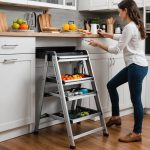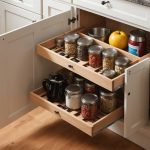Installing a commercial coffee roaster in your café can transform your business, enriching your customers’ experience and enhancing your brand. However, this process requires careful planning and consideration. From selecting the right location to understanding ventilation and power requirements, each decision influences your roaster's performance. This guide highlights essential factors to ensure your installation is smooth, effective, and tailored to your unique café environment. Prepare to elevate your coffee game and delight your patrons!
Space Requirements for a Commercial Coffee Roaster
When considering space planning for a commercial coffee roaster, evaluating the roaster dimensions is essential. The size of the roaster directly impacts your café layout, influencing both the workflow and the overall efficiency of your operations.
Also read : Explore Exotic Ingredients for Crafting One-of-a-Kind Ice Cream Flavors at Your Dessert Bar!
Firstly, it's crucial to measure the dimensions of the roaster to ensure it fits comfortably within your designated space. A larger roaster might require additional ventilation systems and clearance from walls, which must be factored into your space planning.
The café layout should facilitate a smooth workflow, allowing baristas and other personnel to move freely without obstruction. This involves strategically placing the roaster to minimize cross-traffic and optimize the sequence of tasks. For instance, positioning the roaster near storage areas for green beans and roasted coffee can enhance efficiency.
Also read : Key guidelines for selecting eco-friendly seafood for your restaurant menu
Moreover, space allocation must consider not only the roaster but also other essential equipment and personnel. This includes grinders, brewing stations, and seating areas for customers. Adequate space for maintenance and cleaning tasks is also necessary to ensure the longevity and optimal performance of the roaster.
In summary, careful consideration of roaster dimensions, workflow, and space allocation is vital to creating an efficient and functional café environment.
Ventilation Considerations
When setting up a commercial coffee roaster, ventilation systems play a critical role in ensuring optimal air quality and efficient smoke extraction. Selecting the right type of ventilation is essential. Options include ducted systems, which direct smoke and odours outside, and recirculating systems, which filter and return air to the space. Each type has its advantages, with ducted systems often preferred for their effectiveness in removing smoke and odours entirely.
Compliance with health and safety regulations is paramount. Regulations often dictate specific requirements for ventilation to protect both employees and customers. Ensuring your system meets these standards not only safeguards health but also avoids potential legal issues. Consulting with local authorities or experts can provide clarity on these requirements.
Effectively managing smoke and odour control is crucial for maintaining a pleasant environment. Proper ventilation systems should efficiently extract smoke generated during roasting, preventing it from permeating the café. Additionally, odour control measures, such as carbon filters, can neutralise any lingering aromas, ensuring a comfortable atmosphere for patrons.
Incorporating these ventilation considerations into your space planning will contribute to a safer, more efficient, and enjoyable café environment.
Electrical Needs and Requirements
Understanding the electrical specifications of your commercial coffee roaster is crucial for seamless operations. Each roaster model may have distinct power requirements, often influenced by its size and capacity. For instance, larger roasters typically demand a higher voltage and amperage, necessitating a robust power supply system. It's vital to consult the manufacturer’s guidelines to ensure your setup meets these specifications.
Hiring a qualified electrician is not just recommended but essential. They can assess your existing electrical infrastructure and make necessary adjustments to accommodate the roaster's needs. This includes installing dedicated circuits and ensuring that the wiring can handle the load without risk of overheating or tripping.
Adhering to safety standards and regulations is paramount. Compliance with local electrical codes protects your establishment from potential hazards such as electrical fires. Moreover, maintaining these standards can prevent costly fines and ensure the safety of employees and customers alike.
Incorporating these considerations into your planning will help ensure a reliable and safe electrical setup for your coffee roaster, enabling efficient and uninterrupted operations.
Choosing the Right Equipment
Selecting the right coffee roasters for your business is a pivotal decision that impacts quality and efficiency. Understanding the various equipment options available can guide you in making an informed choice. There are several types of commercial coffee roasters, such as drum, fluid bed, and hybrid models, each offering distinct roasting techniques and benefits.
When evaluating equipment, consider the capacity you need. Drum roasters, for example, are known for their consistency and are ideal for larger batches, while fluid bed roasters provide quicker roasting times, suitable for smaller operations.
Factors to consider include the type of roast you aim to achieve, the volume of coffee you plan to produce, and your budget. It's also crucial to examine the ease of use and maintenance requirements of each model.
Brand comparisons can further aid your decision-making. Leading brands like Probat, Diedrich, and Loring offer various models with unique features. Comparing these brands on aspects such as energy efficiency, technological advancements, and customer support can help identify the best fit for your needs.
By carefully assessing these elements, you can select equipment that aligns with your business goals and enhances your coffee production process.
Installation Process
Establishing a commercial coffee roaster involves a detailed installation process that ensures optimal performance and safety. Following installation guidelines is crucial to prevent mishaps and ensure efficient operations. Here's a step-by-step approach:
-
Site Preparation: Begin by clearing the designated area, ensuring it meets the roaster's size and ventilation requirements. Confirm that electrical setups comply with the roaster's specifications.
-
Positioning the Roaster: Carefully place the roaster according to the setup procedures, allowing sufficient clearance for maintenance and operation. Ensure easy access to ventilation and electrical connections.
-
Ventilation and Exhaust Setup: Install the necessary ductwork or filters to manage smoke and odours. This step is vital for maintaining air quality and complying with health regulations.
- Electrical Connection: Engage a qualified electrician to connect the roaster to the power supply, adhering to safety standards and ensuring the system can handle the load.
The importance of expert assistance cannot be overstated. Professional installers bring expertise to navigate common challenges, such as incorrect positioning or inadequate ventilation. They ensure that all components are correctly aligned and functional, reducing the risk of operational issues. Engaging experts not only guarantees a smooth installation but also enhances the longevity and efficiency of your coffee roaster.
Compliance with Local Regulations
Navigating local regulations is a critical step in establishing a commercial coffee roaster. Adhering to these health codes ensures not only the safety of your operations but also the legal standing of your business. Local health and safety codes often encompass requirements for ventilation, waste management, and employee safety. Understanding these codes is essential for maintaining a compliant operation.
Obtaining the necessary permits is paramount. These permits might include health permits, fire safety certificates, or zoning approvals, depending on your location. Securing these permits is a legal obligation and a proactive measure to avoid potential fines or shutdowns. It’s advisable to consult with local authorities or a legal expert to navigate the permit application process efficiently.
Staying updated with evolving regulations and scheduling regular inspections is crucial for ongoing compliance. Regulations can change, and periodic inspections ensure that your establishment meets current standards. Regular reviews of your processes and systems can help identify areas needing improvement, ensuring both compliance and operational efficiency.
By focusing on these aspects, you can create a safer and more reliable environment for both employees and customers, fostering trust and sustainability in your coffee business.
Maintenance and Care Tips
Proper roaster maintenance is crucial for ensuring the longevity and optimal performance of your commercial coffee roaster. Regular upkeep not only extends the life of the equipment but also maintains the quality of the coffee produced.
Routine maintenance practices include checking and tightening all connections and inspecting the roaster for any signs of wear. Cleaning procedures are equally important. Daily cleaning involves removing chaff and residue from the roasting chamber and exhaust system. This prevents build-up that can affect the roast quality and pose fire hazards. Weekly, a more thorough cleaning should be performed, including vacuuming out the cooling tray and inspecting the drum for any blockages.
It's essential to recognise signs of wear, such as unusual noises or decreased roasting efficiency. Addressing these promptly can prevent more significant issues. For example, if you notice uneven roasting, it may indicate a need for drum alignment or burner adjustment.
Implementing these maintenance and cleaning procedures ensures your roaster operates efficiently and safely. By being proactive about care, you can enjoy consistent coffee quality and minimise downtime, ultimately supporting the success of your café business.
Cost Considerations
Understanding the financial implications of acquiring and operating a commercial coffee roaster is vital for any café business. The initial investment in a roaster can vary significantly depending on the model and capacity. High-end models like those from Probat or Loring may require a substantial upfront cost, but they often offer advanced features that can enhance efficiency and coffee quality.
Beyond the initial purchase, ongoing operational expenses must be considered. These include energy costs, regular maintenance, and potential repairs. It's important to account for the cost of consumables, such as filters and cleaning supplies, which are essential for maintaining the equipment's performance.
Effective budgeting involves planning for these expenses and setting aside reserves for unexpected costs. Developing a comprehensive financial plan that includes a breakdown of both fixed and variable costs can help manage cash flow effectively.
Consider implementing strategies such as leasing equipment or seeking financing options to spread out the initial investment. Additionally, exploring energy-efficient models can reduce long-term operational expenses, providing savings over time.
By carefully evaluating equipment costs and operational expenses, you can develop a robust budgeting strategy that supports the financial health of your coffee business.
Case Studies and Real-World Examples
Exploring success stories from the café industry offers valuable insights into effective commercial coffee roaster installations. One notable example is a bustling café in Melbourne that transformed its operations by integrating a high-capacity drum roaster. This setup not only increased their production volume but also enhanced their coffee quality, setting a benchmark for industry standards.
Lessons learned from such real-world experiences highlight the importance of meticulous planning and adherence to best practices. For instance, ensuring proper ventilation and electrical compliance was crucial in avoiding operational hiccups and maintaining a safe environment. These case studies often reveal the significance of strategic layout planning to optimise workflow and customer experience.
Expert insights further enrich these narratives. Interviews with industry professionals underline the necessity of choosing the right equipment and understanding local regulations. Experts often stress the value of regular maintenance and staff training to sustain high performance and quality standards.
By examining these industry benchmarks, café owners can glean practical strategies and avoid common pitfalls. Whether it's through expert advice or peer experiences, these examples serve as a guiding light for those aiming to achieve operational excellence in the coffee business.
Future Trends in Coffee Roasting
In the ever-evolving world of coffee, industry trends are reshaping how we approach commercial coffee roasting. One notable shift is the integration of technology advancements in roasting processes. Automated systems and AI-driven machinery are increasingly popular, offering precision and consistency that manual methods struggle to match. These innovations not only enhance the quality of the roast but also streamline operations, making them more efficient and less labour-intensive.
Moreover, sustainability is becoming a cornerstone of the coffee industry. Roasters are adopting eco-friendly practices to reduce their carbon footprint and promote environmental responsibility. This includes using energy-efficient equipment, sourcing ethically produced beans, and implementing waste reduction strategies. The focus on sustainability is not just a trend but a necessity, as consumers increasingly demand transparency and eco-consciousness from their coffee providers.
As these emerging trends continue to develop, they promise to redefine the landscape of coffee roasting. The fusion of cutting-edge technology with sustainable practices is setting new standards for quality and responsibility in the industry. Embracing these changes will be crucial for businesses aiming to stay competitive and relevant in the future market.











